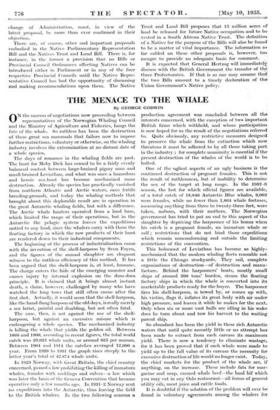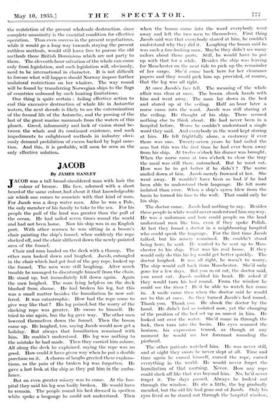THE MENACE TO THE WHALE
By GEORGE GODWIN ON the success of negotiations now proceeding between representatives of the Norwegian Whaling Council and the Ministry of Agriculture and Fisheries, hangs the fate of the whale. So ruthless has been the destruction pf these great sea mammals that failure now to impose further restrictions, voluntary or otherwise, on the whaling industry involves the extermination at no distant date of a whole species.
The days of romance in the whaling fields are past. The hunt for Moby Dick has ceased to be a fairly evenly balanced contest between large-brained pigmy man and small7brained Leviathan, and what was once a hazardous and heroic sea-hunt has become mechanized mass destruction. Already the species has practically vanished from northern Atlantic and Arctic waters, once fertile breeding-grounds, and today the whaling methods that brought about this deplorable result arc in operation in the great Antarctic whaling fields, but with a difference. The Arctic whale hunters operated from a land base, which limited the range of their operations, but in the Antarctic the pelagic system leaves the expeditions untied to any land, since the whalers carry with them the floating factory in which the raw products of their hunt are rendered down to their industrial components.
_ The beginning of the process of industrialization came with the invention of the shell-harpoon by Sven Foyen, and the figures of the annual slaughter are eloquent witness to the ruthless efficiency of this method. It has been argued that the shell-harpoon is, at least, humane. The charge enters the hide of the emerging monster and causes injury by internal explosion on the dum-dum principle. It is claimed that it brings almost instant death,. a claim, however, challenged by many who have watched the long tows that still, often ensue after the first shot. Actually, it would seem that the shell-harpoon, like the hand-flung harpoon of the old days, is really merely a sea lariat, painful and disabling, but not often fatal.
The case, then, is not against the use of the shell- harpoon, but against an excessive misuse which is endangering a whole species. The mechanized industry is killing the whale that yields the golden oil. Between 1868 and 1900, according to recent figures, the total world catch was 20,025 whale units, or around 625 per annum. Between 1904 and 19U the catches averaged 12,000 a year. From 1920 to 1981 the graph rises steeply to the latter year's total of 42,874 whale units.
In 7929 Norway, with Great Britain, the chief country concerned, passed a law prohibiting the killing of immature whales, females with sucklings and calves—a law which was later the basis of the Geneva Convention that became operative only a few months ago. In 1931-2 Norway sent no expeditions into the Antarctic, thus leaving the field to the British whalers. In the two following seasons a production agreement was concluded between all the interests concerned, with the exception of two important British firms which withheld, and whose. participation is now hoped for as the result of the negotiations referred to. Quite obviously, any restrictive measures designed to preserve the whale from the extinction which now, threatens it must be adhered to by all those taking part in the industry ; for complete unanimity is essential if the present destruction of the whales of the world is to be halted.
• One of the ugliest aspects of an ugly business is the continued destruction of pregnant females. This is not the result of ruthlessness, but of inability to determine the sex of the target at long range. In the 1932-3 season, the last for which official figures are available, of a total catch of 18,846 Antarctic Blue whales, 9,062 were females, while no fewer than 1,864 whale foetuses, measuring anything from three to twenty-three feet, were taken, unborn, with their mothers. The Norwegian government has tried to put an end to this aspect of tha slaughter by depriving the harpooner of his bonus when his catch is a pregnant female, an immature whale or calf ; restrictions that do not bind those. expeditions which remain nonconforming and outside the limiting restrictions of the convention.
This holocaust of Leviathan has become so highly- mechanized that the modern whaling fleets resemble not a little the Chicago stockyards. They sail, complete organizations of destruction—of destruction and manu- facture. Behind the harpooners' boats, mostly small ships of around 200 tons' burden, steam the floating factory ships in which the whale, is converted into its marketable products ready for the buyer. The harpooner. fires his shell-harpoon, is towed by, or comes up with, his victim, flags it, inflates its great body with air under high pressure, and leaves it while he makes for the next. Only when six or more vast hulls are idling in his wake does he turn about and tow his harvest to the waiting parent ship.
So abundant has been the yield in these rich Antarctic waters that until quite recently little or no attempt has been made to extract from each carcase its maximum yield. There is now a tendency to eliminate wastage, for it has been proved that if each whale were made to yield up to the full value of its carcase the necessity for excessive destruction of life would no longer exist. Today, the chief markets for the product of the whale are, if anything, on the increase. These include fats for mar- garine and soap, canned whale beef—the hual bif which you may eat in any Oslo restaurant—all forms of general utility oils, meat juice and cattle foods.
It is doubtful if the solution of the problem will ever be found in voluntary agreements among the whalers for the restriction of the present wholesale destruction, since complete unanimity is the essential condition for effective operation. Thus even success in the present negotiations, while it would go a long way towards staying the present ruthless methods, would still leave free to pursue the old methods those British Dominions which are not party to them. The eleventh-hour salvation of the whale can come only froni legislation, and such legislation will, obviously, need to be international in character. It is not difficult to foresee what will happen should Norway impose further unilateral restrictions on her whalers. The way round will be found by transferring Norwegian ships to the flags of countries unbound by such hunting limitations.
One• thing is quite certain : failing effective action to end this excessive destruction of whale life in Antarctic waters, the next decade is likely to see the extermination of the fecund life of the Antarctic, and the passing of the last of the great marine mammals from the waters of this planet. Greed, inhumanity and lack of vision stand be- tween the whale and its continued existence, and such impediments to enlightened methods in industry obvi- ously demand prohibition of excess backed by legal sanc- tion. And this, it is probable, will soon be seen as the only effective solution.



































































 Previous page
Previous page